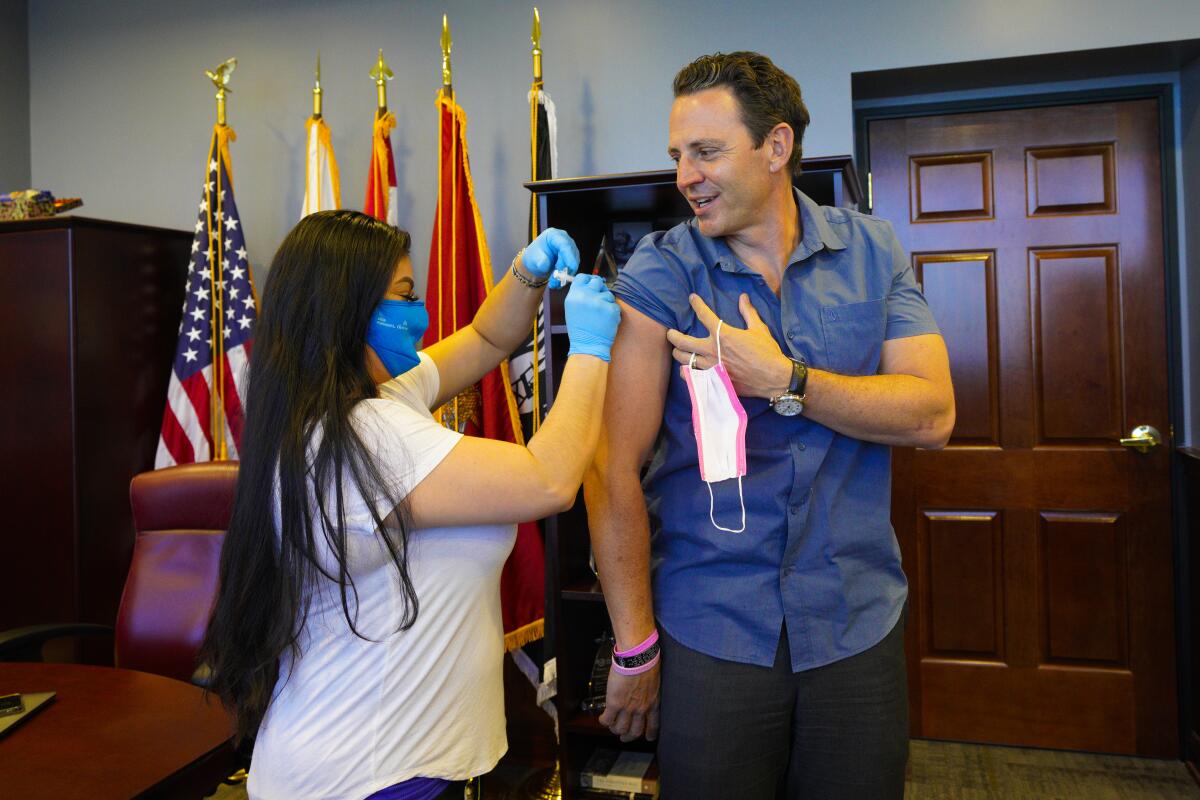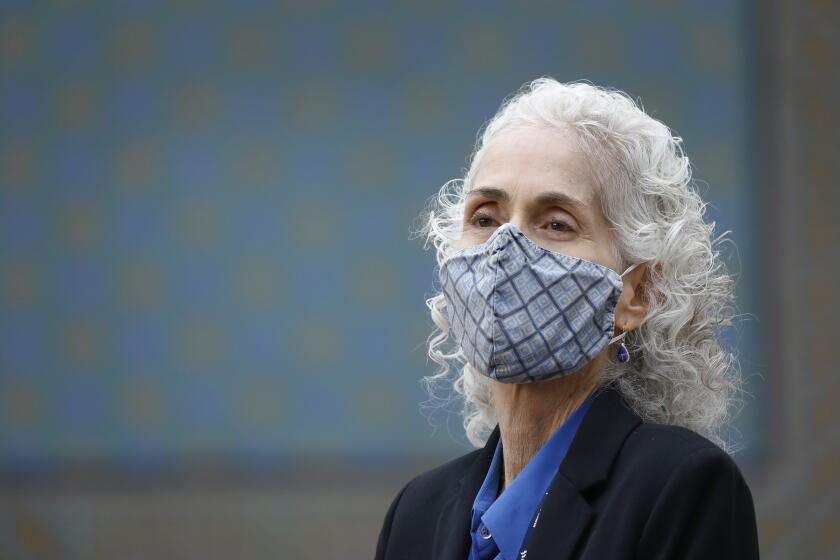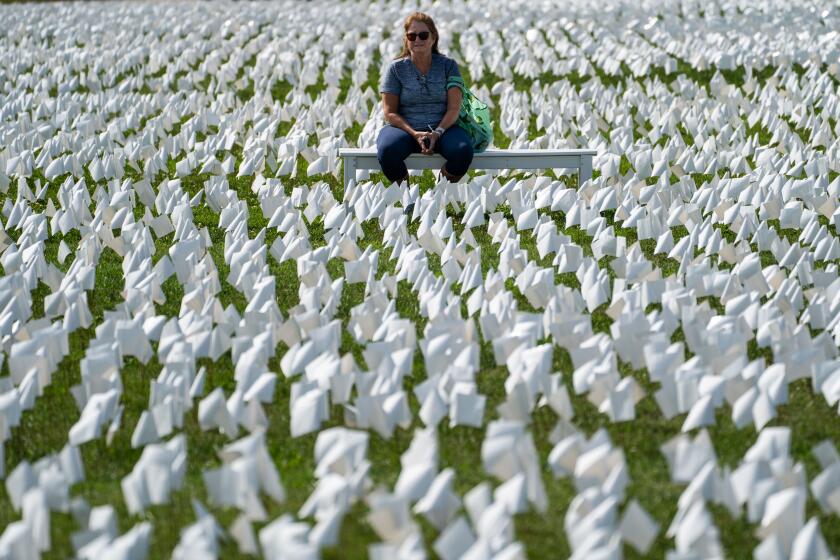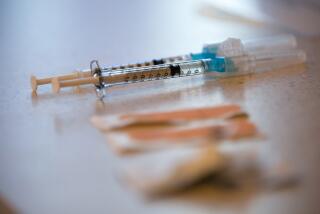With 80% of eligible San Diegans fully vaccinated, county won’t issue indoor vaccine mandate

Officials say they don’t plan to require proof of COVID-19 vaccination for entry into San Diego County restaurants, shopping centers and other indoor settings.
The Wednesday announcement came a week after the Los Angeles City Council voted 11 to 2 to require proof of full vaccination at indoor venues throughout the city. That mandate takes effect in November. Nathan Fletcher, chair of the Board of Supervisors, said San Diego County won’t follow suit.
“Our vaccination rates are some of the highest in the nation and our COVID cases are clearly declining,” Fletcher said in a statement. “At this time, San Diego County has no plans to mandate vaccines at local businesses.”
It also doesn’t seem that the state plans to issue a vaccine mandate. In response to an inquiry from the San Diego Union-Tribune, the California Department of Public Health said individual counties can take pandemic precautions that are stricter than the state’s stance.
The city of San Diego won’t mandate vaccination for entry into indoor spaces either, said Courtney Pittam, press secretary for Mayor Todd Gloria, unless the county changes its guidance.
It’s not the first time San Diego and Los Angeles have taken different approaches to control the spread of the coronavirus. In July, Los Angeles County reinstated an indoor mask mandate in a bid to slow cases and hospitalizations fueled by the fast-spreading Delta variant. Weeks later, officials asked San Diegans to mask up, too, regardless of whether they were vaccinated or not. But the San Diego announcement was simply a recommendation, not a mandate.
Public health officials are recommending everyone get a flu shot now to stave off a potentially bad season.
Infections and hospitalizations have steadily decreased in San Diego. On July 23, the county reported about 1,200 new cases, the highest single-day total since February. On Wednesday, the county reported 333 additional cases.
The percentage of tests coming back positive has also dipped from 8.8% in early August to 3.1% at the end of September, according to the latest local report. And the number of San Diegans hospitalized with COVID-19 has dipped from 537 a month ago to 287.
One potential reason for this improvement even without a mask mandate is that San Diego has a higher vaccination rate than Los Angeles. About 70% of Angelenos 12 and older are fully immunized, says L.A. County’s Public Health Department; that’s the age group that’s currently eligible. By comparison, roughly 80% of San Diegans 12 and older are fully vaccinated, which is also above the statewide rate of 72%.
It’s clear that those who aren’t fully vaccinated are bearing the brunt of the pandemic. County figures released last week showed that residents who weren’t fully vaccinated accounted for 75% of infections, 98% of hospitalizations and 86% of COVID-19 deaths between mid-September and mid-October. And 31 of the 37 additional COVID-19 deaths the county has reported since last week have been among those who weren’t fully immunized.
Statewide numbers of new coronavirus infections and COVID-19 hospitalizations have been falling for weeks, but daily death counts have remained high.
The divide between the vaccinated and unvaccinated could grow as the Food and Drug Administration and the Centers for Disease Control and Prevention roll out booster shots. Starting late last month, those who had received their second dose of the Pfizer vaccine at least six months ago became eligible for a third shot if they were 65 or older or at risk of severe COVID-19 based on their health or living and working conditions. That includes healthcare workers, grocery clerks and people in homeless shelters.
Those who got the Moderna or Johnson & Johnson vaccines are not eligible for boosters, but that could change soon.
Dr. Mark Sawyer, an infectious-disease expert at Rady Children’s Hospital in San Diego, served on the advisory panels that recommended that the FDA authorize all three vaccines, and he recently voted to endorse boosters of Pfizer’s shots.
“If I had to guess, by the time we get all done, the recommendation for Moderna and J&J is likely going to be the same as it finally ended up for Pfizer,” he said. “But I don’t really know that.”
Sawyer emphasized that the main way to end the pandemic remains to vaccinate the unvaccinated. That’s supported by local data.
Over the last month, about 9.6 out of every 1,000 residents who weren’t fully vaccinated got a coronavirus infection. That figure dwarfs differences in so-called breakthrough infection rates among the fully vaccinated, with rates of 2, 2.5 and 3.5 cases per 1,000 residents for the Moderna, Pfizer and Johnson & Johnson vaccines, respectively.
There’s one group of residents who still aren’t eligible for vaccination: children younger than 12. But on Sept. 20, Pfizer announced that a study of its vaccine among more than 2,260 kids showed the shots were safe and sparked strong immune responses.
On Oct. 26, the FDA’s advisory panel will meet to discuss Pfizer’s bid to offer its vaccine to kids 5 to 11. Roughly 344,000 San Diegans are in that age range and, depending on what the FDA and CDC decide, could be eligible by the end of the month.
Public health officials are also pushing hard for everyone to get flu shots as the region heads into the fall and winter months.
Wednesday morning, Supervisor Fletcher publicly received his flu vaccine.
Moments later, the county announced that San Diego has logged 195 confirmed flu cases in 2021, an uptick from the region’s five-year average of 128 cases by mid-October.
The state Public Health Department also urged Californians to get their flu shots, essentially saying that one fast-spreading virus is enough.
“In the midst of a COVID-19 pandemic, a severe flu season could be devastating for California,” California Public Health Director Dr. Tomás J. Aragón said in a statement. “Getting a flu shot is a safe and simple thing we can all do to keep people out of the hospital and reduce the strain on our healthcare system.”
More to Read
Sign up for Essential California
The most important California stories and recommendations in your inbox every morning.
You may occasionally receive promotional content from the Los Angeles Times.













